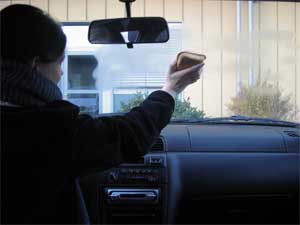 Maybe you've heard a lot about nanotechnology in the news but haven't actually seen any products available in the market. At the Consumer Electronics Show in Las Vegas, Planet82 displayed new prototype cameras called the "Nano-Cam".
Maybe you've heard a lot about nanotechnology in the news but haven't actually seen any products available in the market. At the Consumer Electronics Show in Las Vegas, Planet82 displayed new prototype cameras called the "Nano-Cam".
What is a Nano-Cam? Well, Planet82 used nanotechnology to produce imaging sensors that could give cameras "nightvision". The images aren't crystal clear, but they can spot just about anything in the dark.
One possible application of Planet82's technology is to spot children or pets that may be behind your car in a pitch black driveway.
Source: See in the dark with nanotechnology
Look Ma, No Light!
Posted by
Clarissa Lui
at
1/21/2007 11:55:00 AM
0
comments
![]()
![]()
Playing with Soap Bubbles
 Wouldn't it be cool to earn your living by playing with soap bubbles? Well, that's what Paul Steen does. Paul Steen, a professor in the School of Chemical and Biomolecular Engineering at Cornell University studies the self assembly of thins films by surface tension. One of his latest project is an electrical switch made of water. By using electricity to create and release an adhesive bond between a droplet of water and a flat plate, Steen demonstrates the power of surface tension. A palm beetle can cling to a leaf with a strength equal to 100 times its body weight - which would be equivalent of Steen supporting six or seven cars with a bead of spit!
Wouldn't it be cool to earn your living by playing with soap bubbles? Well, that's what Paul Steen does. Paul Steen, a professor in the School of Chemical and Biomolecular Engineering at Cornell University studies the self assembly of thins films by surface tension. One of his latest project is an electrical switch made of water. By using electricity to create and release an adhesive bond between a droplet of water and a flat plate, Steen demonstrates the power of surface tension. A palm beetle can cling to a leaf with a strength equal to 100 times its body weight - which would be equivalent of Steen supporting six or seven cars with a bead of spit!
The device has no solid moving parts, turns on and off in under a second, runs on less than five volts and can be used either by itself or in larger arrays. If engineered down to the nanometer scale, an array of switches could allow Steen to walk across the ceiling of his office, focus the lens of a cell phone camera, or act as a microscopic, energy-efficient lab-on-a-chip.
Source: Paul Steen's latest invention makes a walk on the ceiling not so far-fetched
Posted by
Clarissa Lui
at
1/06/2007 12:02:00 PM
0
comments
![]()
![]()
Labels: Physics
Anti-Fogging Windshields Through Nanotechnology
 On cold winter mornings, when you first start driving, your vision is often blurred by moisture fogging up the windshield. This happens when warm, humid air from your car heater comes into contact with a cold surface. There is a particular temperature called the dew point where the moisture in the air condenses and forms a layer on the colder surface. This can be prevented by opening the windows, heating the entire car interior, or by just heating the windshield to a temperature above the dew point.
On cold winter mornings, when you first start driving, your vision is often blurred by moisture fogging up the windshield. This happens when warm, humid air from your car heater comes into contact with a cold surface. There is a particular temperature called the dew point where the moisture in the air condenses and forms a layer on the colder surface. This can be prevented by opening the windows, heating the entire car interior, or by just heating the windshield to a temperature above the dew point.
Ivica Kolaric of Fraunhoger Technology Development Group TEP in Germany has developed a new process to warm up the windshield by using a transparent coat of carbon nanotubes. When attached to a power supply, this coating is transformed into a wide, flat heater. This technology, however, is not limited to car windshields. Someday, you might find carbon nanotubes in your bathroom mirrors as well!
Source:Anti-fogging windshields through nanotechnology
Posted by
Clarissa Lui
at
1/06/2007 12:00:00 PM
0
comments
![]()
![]()
On The Cutting Edge
 Researchers at the National Institute of Standards and Technology (NIST) and the University of Colorado at Boulder have designed a carbon nanotube knife that could theoretically work like a tight-wire cheese slicer. The conventional diamond or glass knives that biologists use to cut frozen cell samples often force samples to bend and crack. Because carbon nanotubes are extremely strong and slender in diameter, they make ideal materials for thinly cutting precise slivers of cells.
Researchers at the National Institute of Standards and Technology (NIST) and the University of Colorado at Boulder have designed a carbon nanotube knife that could theoretically work like a tight-wire cheese slicer. The conventional diamond or glass knives that biologists use to cut frozen cell samples often force samples to bend and crack. Because carbon nanotubes are extremely strong and slender in diameter, they make ideal materials for thinly cutting precise slivers of cells.
Why do we need to slice cells? Electron tomography can create 3D images of cells and tissues for scientists to stuy, but the sample needs to be less than 300 nanometers thick. The nanoknife is a carbon nanotude welded to two electrochemically sharpened tungsten needles. The research team has found that the welds were the weakest points in the nanoknife, and are now looking for new and improved welding techniques.
Source:On The Cutting Edge: Carbon Nanotube Cutlery
Posted by
Clarissa Lui
at
1/06/2007 10:07:00 AM
0
comments
![]()
![]()

